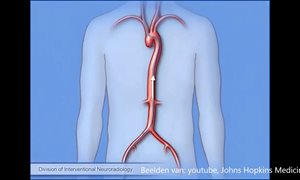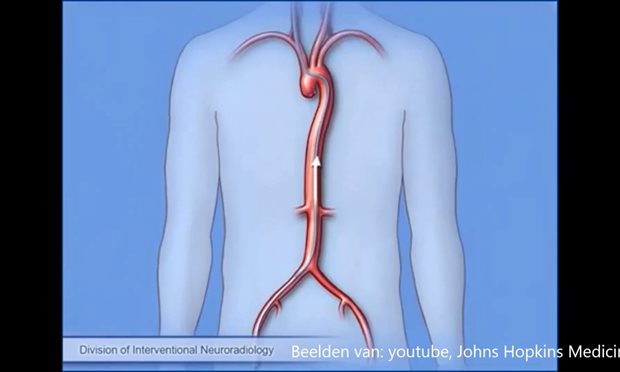What is an AVM?
An arteriovenous malformation (AVM) is a malformation in the vascular system. There is an abnormal connection between an artery and a vein. read moreWhat is an AVM?
What is an AVM?
An arteriovenous malformation (AVM) is a malformation in the vascular system. There is an abnormal connection between an artery and a vein. Normally, an artery supplies oxygen-rich blood under high pressure. The blood flows past the brain cells via capillaries. The oxygen is released there. The oxygen-depleted blood is then drained via small draining capillaries to the large draining veins. These capillaries are missing in an AVM. Instead, there is an abnormal tangle or network of connecting vessels between the artery and the vein. This results in high pressure on the draining vein or veins.Cause and development
The cause of an AVM in the brain is not known. We think that certain people are “predisposed” to developing an AVM even before they are born, and that the AVM develops during their lifetime and often becomes evident between the ages of 20 and 40.How common is an AVM?
An AVM is quite rare. It is not clear how many people have an AVM in the brain. An AVM is diagnosed in one in every 100,000 people annually.Symptoms
Approximately 70% of all AVMs are discovered before a hemorrhage occurs. This discovery is usually made due to symptoms such as an epileptic seizure, temporary speech disturbance or paralysis. We think that this is caused by a lack of oxygen supply to the relevant part of the brain. An AVM can also be discovered by coincidence, if a scan of the head is performed for other reasons.Treatment
An AVM that has not started hemorrhaging does not always require treatment. In certain cases, treatment is not even the best option. Your treating physician will discuss this with you.If the AVM does require treatment, then the aim of the treatment is to completely eliminate the AVM to prevent a hemorrhage or to reduce/stop symptoms.


Examination and diagnosis
If you have an AVM, you will be referred to a neurosurgeon or a neurologist specialized in the vessels of the brain. An examination of the blood vessels (angiogram) is necessary to gain a good understanding of the AVM and how it communicates with the surrounding vessels. read moreTreatment Tangle of blood vessels in the brain (AVM)
The aim of the treatment is to completely eliminate the AVM to prevent a hemorrhage or to reduce/stop symptoms. There are various treatment techniques to achieve this goal. read moreLiving with an AVM
-
When an AVM is discovered, this often results in uncertainty about performing activities that can increase the pressure in the head. Examples include flying, scuba diving, roller coasters, straining, going to the sauna or having sex. There are no indications that these activities increase the risk of bleeding from an AVM. These activities can be performed as normal.
-
An AVM in the brain may have a slightly increased risk of bleeding during pregnancy. If you wish to have children, it is best to discuss with your treating doctor whether this is a reason to seek treatment for the AVM.
-
An AVM in the brain is not hereditary, but does occur in a number of hereditary syndromes, such as Rendu-Osler-Weber disease, the Sturge-Weber syndrome and Klippel-Trenaunay syndrome. If your doctor suspects that you have an AVM in conjunction with a hereditary syndrome, then you will be referred to a clinical geneticist for investigation of this syndrome and to advise your family about screening.
-
There are legal requirements determining the suitability for driving motor vehicles, based on the “driving suitability requirements” guideline of the Dutch Healthcare Inspectorate. The CBR (Dutch equivalent of the DMV) enforces these requirements.
If you have an AVM without symptoms, that has not hemorrhaged, then there are no restrictions for the use of motor vehicles.
If the symptoms of the AVM affect your ability to drive, then your specialist will need to draft a report about this. The CBR can use this report to determine whether an additional, independent medical inspection or a driving test is necessary. Your medical specialist will write the report in addition to the health declaration from the CBR.
In the case of epilepsy caused by an AVM, you can be deemed fit to drive after being seizure-free for a certain period. The duration of the seizure-free period depends on various factors. Discuss with your specialist what applies to you.
